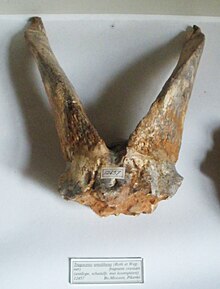Tragoportax
| Tragoportax Temporal range:Miocene
~ | |
|---|---|

| |
| Horns ofTragoportax amalthea | |
| Scientific classification | |
| Domain: | Eukaryota |
| Kingdom: | Animalia |
| Phylum: | Chordata |
| Class: | Mammalia |
| Order: | Artiodactyla |
| Family: | Bovidae |
| Subfamily: | Bovinae |
| Tribe: | Boselaphini |
| Genus: | †Tragoportax Pilgrim,1937 |
| Type species | |
| Tragoportax salmontanus[1] Pilgrim, 1937
| |
| Species | |
| |
| Synonyms | |
Tragoportaxis an extinctgenusofbovidungulate.It lived during the upperMiocene,and its fossils have been found inEurope,AsiaandAfrica.[4]Tragoportaxis sometimes considered to have been a close relative of the extantnilgai,though it may have formed its ownsubfamily,along withMiotragocerus.[3]
Description
[edit]Species within the genusTragoportaxwere sexually dimorphic, and were variable in size, although most were about the size of ared deer.[3]
Skull
[edit]TheskullofTragoportaxhad a short snout and elongated rear. The horns were large and curved backwards, and in some species (notablyT. amaltheaandT. perses) were twisted. The horns of females and young were smaller and thinner than those of adult males; in both sexes, the horns had a well-marked posterolateral keel and flat sides. The cross-section of the horns was usually triangular or subtriangular. Compared to those of the relatedMiotragocerus,the horns were less laterally compressed.[3]
Classification
[edit]The first fossils ofTragoportaxwere described in 1854 by Roth and Wagner under the nameCapra amalthea,and a few years later Gaudry (1861) thought it appropriate to reclassify these fossils into a genus of their own (Tragocerus). The nameTragocerus,however, was preoccupied by alonghorn beetle,[5]and it was therefore necessary to rename the animal. In1937,Guy Ellcock Pilgrimcoined the generic nameTragoportax.[1]
Species
[edit]Several species are known from the genus Tragoportax: the type species isT. salmontanus,described byGuy Ellcock Pilgrimin 1937 on the basis of fossils found on theSiwaliksin Pakistan;[1]other well-known species areT. amalthea,well known thanks to several fossils found in the Greek deposit ofPikermi,andT. rugosifrons,widespread (Greece, Macedonia, Bulgaria, Moldova, Ukraine, Pakistan, Iran). Other lesser-known species areT. maius(a possible synonym ofT. eldaricus)[3]of Georgia and Azerbaijan,T. cyrenaicusof Libya,T. macedoniensisof Greece andT. acraeof South Africa. The latter species may have been the last to disappear, in the early Pliocene, and was originally ascribed to a separate genus,Mesembriportax.Another well-known species often ascribed toTragoportaxisT. gaudryi,from various European deposits: however, this form has been reclassified as a species of the related genusMiotragocerus.[6]In 2023, a new species,Tragoportax perses,was described.[7]
Phylogeny
[edit]The classification ofTragoportaxand its kin remains a matter of debate. It has commonly been assigned to the tribeBoselaphini,alongside the modernnilgai.[3]Bibi et al. (2009) suggested that modern boselaphines and their Miocene relatives should be separated, withTragoportaxbeing reassigned to the tribeTragoportacini,[8]which also includesMiotragocerus.[8][9]
Paleobiology
[edit]The long legs ofTragoportaxindicate that this animal wascursorial,moving quickly across open, forested plains, and was probably also a good jumper. A 2004 study indicates thatTragoportaxwas stronglysexually dimorphic,based on the shape and size of the horns.[3]
References
[edit]- ^abcPilgrim G. 1937. - Siwalik antelopes and oxen in the American Museum of Natural History. Bulletin of the American Museum of Natural History 72: 729-874.
- ^Gaudry A. 1861. - Résultats des fouilles exécutées en Grèce under the auspices of the Académie. Comptes Rendus de l'Académie des Sciences de Paris 52: 297-300.
- ^abcdefghijklmSpassov N. & Geraads D. 2004. -Tragoportax Pilgrim, 1937 and Miotragocerus Stromer, 1928 (Mammalia, Bovidae) from the Turolian of Hadjidimovo, Bulgaria, and a revision of the late Miocene Mediterranean Boselaphini.Geodiversitas26(2): 339-370.
- ^Solounias N. 1981. - The Turolian fauna from the Island of Samos, Greece with special emphasis on the Hyaenids and the Bovids. Contribution to Vertebrate Evolution 6: 1-232.
- ^Mindat.org: Tragocerus.mindat.org.Retrieved 2021-02-10.
- ^D. S. Kostopoulos. 2016. Artiodactyla - Palaeontology of the upper Miocene vertebrate localities of Nikiti (Chalkidiki Peninsula, Macedonia, Greece). Geobios 49:119-234 [E. Vlachos/E. Vlachos/E. Vlachos]
- ^Orak, Zahra; Kostopoulos, Dimitri S.; Ataabadi, Majid M. (May 22, 2023)."Late Miocene large-sized Bovidae (Mammalia) from Dimeh, SW Iran: contribution to depositional diachrony and palaeobiogeography".Geobios.
- ^abBibi, Faysal, Bukhsianidze, Maia, Gentry, Alan W., Geraads, Denis, Kostopoulos, Dimitris S., and Vrba, Elisabeth S., 2009. The Fossil Record and Evolution of Bovidae: State of the Field. Palaeontologia Electronica Vol. 12, Issue 3; 10A: 11p;http://palaeo-electronica.org/2009_3/169/index.html
- ^Qin-Qin Shi & Zhao-Qun Zhang (2023) New material ofMiotragocerus(Bovidae, Artiodactyla) from northern China and its systematic implications,Journal of Systematic Palaeontology,21:1,doi:10.1080/14772019.2023.2194891
